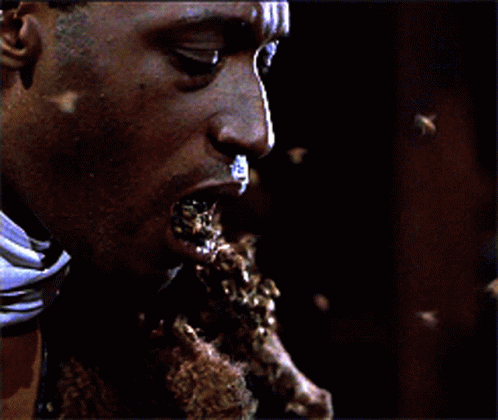So if I understand you correctly, if I remove my lungs, I’m a bee? My aunt had lung cancer, so they’ll probably kill me, anyway. I’ll report back on the results.
No because you’re likely too big (no offense) :(
I think insects have little holes all over their bodies, in which air gets inside by itself through some physics shenanigans. It doesn’t need to be actively sucked in like with lungs, it just happens because they’re so small.
This method doesn’t scale up though since if you’re bigger, you need more air, and having little holes all over your body won’t cut it. Thats when you know you need lungs, and that’s why you don’t see insects the size of a dog these days (thankfully).
There used to be times in the Earth’s history (Carboniferous) where the air’s composition was different though, and since it had more oxygen in it, insects could grow a lot larger.
Fun fact: Cutaneous respiration (aka “Skin breathing”) is something we humans do too. But it accounts only for 1% to 2% of our oxygen input.
However, the cornea of our eyes doesn’t have its own blood vessels to supply it. Therefore, it relies on direct gas exchange with the environment—in other words, skin respiration.
Our eyes breath like bees.
Is that why bees can’t wear contact lenses?
No, it’s because they have compound eyes. Even if they could afford all the different lenses they need, they’d never have enough time to put them in and take them out, while still working a full day.
surely they could just make one big lens with facets in it? sure they’re gonna be hellishly expensive but at least they’re usable
Honestly, I was already out of my depth with the entomology and ophthalmology discussed here. The economics of bee optometry might be a bridge too far for me. Can a bee make enough honey to afford such lenses? If so, does it improve the bee’s ability to make honey enough to justify the cost? I have no idea and no clue regarding how to investigate this issue.
perhaps we’re coming at this from the wrong direction, does a bee even need lenses? maybe what they actually need is just eye protection, which would make everything much cheaper
So what you’re saying is I have two eyes in my beeholes?
I like this fact. That’s why it’s so important to take out certain kinds of contacts at night.
1-2% is more than I’d have imagined!
Adding to this, the holes (spiracles) connect to the tracheae, which connect to air sacs. While respiration is almost entirely passive in smaller species, larger species actually force air through the system to aid the otherwise passive process.
https://en.m.wikipedia.org/wiki/Respiratory_system_of_insects
Side note: Spiders have book lungs. They’re not insects, but like insects, they are arthropods.
So theoretically if we terraformed the Earth we would be free to genetically engineer humans to survive without lungs?
They wouldn’t be human. So much of us is built around our lungs, including our ability to speak that anything adapted to survive without them would be as different from a human as a human is from other lung-less animals. Even if they were more intelligent, they would not look or act remotely like a human.
Keyword suggestion: https://en.wikipedia.org/wiki/Transhumanism
Okay, first of all, how dare you bring evidence and reason into this.
On a more serious note, I agree with the position mentioned in the second paragraph that transhumanism results in a posthuman being, that is, a species that is not human.
Human is such a flaky word, and species isn’t much better. I’d bet there could be a situation in which they can successfully interbreed with relatively modern humans and still produce viable offspring, so still the same species. Human doesn’t even require homo sapiens though. It can include other species that have the traits of humans.
You’re not wrong. One group will displace the other, though. Some of us Homo Sapiens still have genes from Homo Neanderthalensis. Neanderthals aren’t around anymore, though. Also, archeological evidence suggests they didn’t spend much time together.
It’s been a long time since I’ve seen it but the movie Mimic had bugs that had grown to the size of a human and taken on a vaguely human form in order to hunt us.
The movie used the reasoning that the bugs had developed basic lungs which enabled them to grow past the limits of their usual breathing apparatus.
No point to make here, I just remember it being cool that they put a small amount of thought into why the bugs could grow to human proportions.
Kafka’s Gregor would like a word.
Yeah, and if you pluck a chicken, it will be a human, because it’s featherless and stands on two legs.
But what came first, the human or the egg?
I don’t have a clever response, so I’ll just point out that eggs predate vertebrates by millions of years.
Nah-ah, that makes it a dinosaur!

Wait till you hear about Eric the half a bee
I do love me some Monty Python. I can never pick a favorite sketch. It keeps changing. The Parot sketch is definitely top ten.
Diogenes my goat
Glad you brought this up. I’m doing some work in this rich guy’s house and I can’t find a single spittoon.
That is almost how it works, but to really become a bee you’ll have to turn the lungs into wings. Good luck. I’m looking forward to seeing the result.
[Lung flapping sounds]
Mm moist.
It would definitely change the nature of romance and sex.
If you like reading, maybe a half-way solution could be achieved with book lungs like a spider.
Non-insect arthropods FTW!
Then, when your spouse hugs you, they’ll have beauty in their eye.
Bee holder
left wiggle, right wiggle, left wiggle, buzz
WHAT! MY MOTHER WAS A SAINT!
My Aunt Bee had lung cancer
And, for the most part, humans’ lungs don’t have bees!
I somehow forgot about bees not having lungs. I knew some other small things didn’t.
What’s that? Human lungs don’t have bees?!
A large influx of bees ought to put a stop to that!
Speak for yourself
I find that hard to beelieve
I’m skeptical too, but that’s the buzz.
Most invertebrates have no internal air sac breathing organ. Arachnids kinda do, and I’m seeing something about semi-aquatic snails, but direct diffusion is pretty efficient at that scale.
Axolotls have them despite not needing them because they can live just fine without ever inhaling air for their entire life. But they sometimes do it for fun and then blow out bubbles.
Amphibians are the weirdest vertebrates.
Looking at my axolotl that is currently trying to pretend to be a plant, yep.
Beekeepers intentionally use smoke to make bees docile during collection time, transfers, etc
However, what I’ve heard from a beekeeper is that the smoke triggers a flight response in them (from fire) so they consume honey ready to flee, and that’s actual what makes them docile/drowsy.
You’re telling me the bees get the munchies when they smoke…
Pretty shitty instinct if it means they end up sleeping instead of fleeing.
I think if it comes to it they just flee, drowsily, with full bellies of honey - so they’ve got energy to fly and something left over to start the new hive.
This is (fortunately) why there’s a maximum size on insects. The environment is less oxygen rich today than in the eras of giant insects in the past. They reach a size where oxygen can’t penetrate deeply enough onto their bodies.
It’s all based on a very fundamental mathematical law: if you increase the size of something, the volume increases with the third power while the surface area increases with the second power. An insect twice as large would be 8x as heavy and need 8x as much oxygen but 4x as much surface area.
That’s also the reason why insects are as strong as they are. The strength of a muscle scales primarily with the cross section area of it, which again scales with the second power. So if you’d increase the weight of an ant by a factor 10,000,000 (e.g. 5mg to 50kg), the expected strength would increase by 10,000,000^(2/3) ≈ 46,400. If it could lift 10x it’s weight at the original size, it could now only lift about 4.6% of it’s weight
Reminds me of how the damage to roads scales with the weight of the vehicle to the 4th power, so someone driving a 6000lb pickup does 16x more damage to roads than a 3000lb sedan
How does double the mass increase the damage 16 fold? I understand surface area vs volume, but that doesn’t seem relevant when working with mass
It’s more about a minimum of weight or pressure that affects it. So the higher the pressure the more likely it is to flex the road where a small vehicle with light pressure might not make it flex at all. The heavier it is the more the weight will flex the subsurface and cause more damage.
“To give you an example of that impact, let’s do a quick calculation. Here in New Zealand, the heaviest vehicle allowed on (some of) our roads is the 50MAX truck. It has nine axles and a total weight of 50 tonnes, so the load-per-axle is 5.55 tonnes. The best-selling car in NZ in 2022 was the Mitsubishi Outlander. It weighs 1.76 tonnes, so its load-per axle is 0.88 tonnes. The fourth-power law says that to calculate the relative stress that these two vehicles apply to a road, you take the ratio of their loads-per-axle and raise the result to the fourth power. In this case, (5.55 / 0.88)4 = 1582. In practical terms, it means that a 50MAX truck applies as much stress to a road as 1,582 cars (or quite literally billions of bicycles)”
Square Cube Law
maybe once I have money for hobbies, but I really want to make oxygen rich terrariums, and selectively breed tarantulas to see if I can make them larger.
No!
Keep in mind it will be inherently escape proof.
if I manage to make meter wide spiders, they would suffocate as soon as they leave the enclosure.

although If they get big enough, I could have oxygen breathers I could attach to their tracheas.
try escaping my giant semi mechanised murder wasps
This is giving Island of Dr. Moreau
As long as you leave the centipedes out of it
And a separate tank for Scorpions to fight them, we’ll make a killing
Then a youtube channel to praise the crowd
On lungless insects. If they develop to be larger they will get lungs!
As long as they mutate it
As lung* as they mutate it.
Yeah giant insects would be utterly terrifying (and deadly).
Insects don’t have lungs. It also means their potential size is directly limited by the oxygen content in the air.
Which is why we don’t see cat sized insects roaming around.
Which is why you don’t see cat sized insects roaming around, I live next to a tarantula trail and some of them fuckers get BIG.
Spiders aren’t insects. Though like them, they don’t have lungs! Not ones like ours, anyway.
In my defense I am a smartass not smart.
Eh, you were close enough.
tarantulas do indeed have lungs though
deleted by creator
Yeah they followed paths, I think it’s a way of avoiding dangerous terrain. They are rather fragile beasts.
Arachnids are not insects though.
Related is this awesome video discussing dinosaur breathing
that was great! thanks!
Huh, the Greek hero Spiracles saved the bees
TIL
Obviously, the Greek hero Spiracles also rhymes with the bees
Hold on, wait a minute, pause. There are people who think that bugs have lungs?
To be fair, while bugs and other insects don’t have lungs, some arthropods do. The differences among arthropods, insects and bugs aren’t exactly common knowledge.
some have book-lungs not true lungs. Only us fish have “true” lungs
edit: this thread turned into nerd-heaven. i love it!
Agreed. I was referring to book lungs.
Also, I feel like you got some ‘splainin’ to do regarding the fish reference.
deleted by creator
Fish is a polyphyletic group. It’s a shorthand to refer to various lines of aquatic vertebrates with a similar anatomy. It’s not a clade but that’s not the only way to logically group organisms. People trot it out like a “gotcha” or just misuse it in much the same way they don’t understand speciation (or most science terminology, to be frank)
We are not fish by anyone’s honest definition, but “there’s no such thing as a fish” is the kind of attention-grabbing false revelation I hate: it’s the headline with none of the understanding to actually learn something.
(I’m not annoyed at you, I think you understand perfectly based on your wording)
deleted by creator
I too have seen that Clint’s Reptiles video, lmao
From what I understand, this is sorta like a hangover from pre-DNA taxonomy. We went “yeah, those all look like fish, we’ll put them in the fish group”, only to find out later that a bunch of them weren’t very closely related at all. So now we have a ‘fish’ group that’s a total mess, and we’re in the middle of getting it organized and re-labelled.
deleted by creator
Can’t we just un-fish it like we do for other clades when we need to?
“There’s an ape in the office!”
“Yes, his name is Tom. More importantly, he is a human being, and we don’t refer to them as apes outside of an academic context and even then, only when necessary.”
[Tom eats a banana, screams at an intern, and starts picking his nose]
No, fuck paraphyletic groups.
I meant, can’t we just be more specific rather than use paraphyletic grouping?
“What’s for dinner?”
“Fish”
“That could mean anything!”
“You know I meant Actinopterygii.”
“Still pretty broad.”
“Oncorhynchus.”
“You know how I feel about trout.”
“Ugh. tshawytscha.”
“Well, why didn’t you just say so in the first place?”
We’re all descended from fish.
Also, IIRC, some fish are more closely related to us than they are to other fish, making it impossible to biologically define a category of animal that includes everything we call a fish but doesn’t include us.
Thanks!
Also, I recognize your username. I feel like you may have encountered my ignorance on at least one previous occasion.
Only us fish have “true” lungs

Usually not lungs as they exist in mammals, though.
You’re right. They’re different.
It’s funny that this is biology in 4th grade and half the people here are shocked
I didn’t think bees had lungs. I also didn’t think bees didn’t have lungs…
I’m less bothered by that person not knowing and way more bothered by them just being so confidently incorrect. Doesn’t take long to just look it up yourself. Unless the whole post was an educational setup?
Hunh. TIL.
Not just bees, it’s true of all insects.
Consequently, the amount of oxygen in the air determines how big bugs can grow. Get too big, and the oxygen can’t diffuse into the body fast enough. This even shows up in the fossil records, with larger bugs being found alongside evidence of eras that had more oxygen in the atmosphere.
They aren’t insects, but most arachnids have book lungs, which are basically a pocket full of air gills.
How much was the oxygen and where has it gone since then?
Currently oxygen is about 20% of the atmosphere. In the Carboniferous period, 60 million years ago, it’s thought to have gotten as high as 30%.
Oxygen is highly reactive, and the O2 configuration is not particularly stable, so over time it gets locked up in other molecules, which are then burred or deposited at the bottom of bodies of water.
Oxygen has always been plentiful on earth, but for most of geologic history it was bound up in solid molecules in the crust. Nearly 2.5 billion years ago, bacteria began “unlocking” gaseous O2 as a byproduct of the nitrogen based chemical reaction they lived on.
Well that’s a Christmas spiracle
Just laughed aloud in a café, thanks for that
they don’t have circulatory systems either they’ve basically just pushing things through themselves and tryna make it work
Pedant here. They absolutely do have circulatory systems. They have what’s known as an open circulatory system, whereas we have a closed circulatory system.
“I’ve been trying to quit smoking. I want to take better care of my spiracles”
Wait until this person hears about fish.
don’t beekeepers use smoke or some such?
Yup. It simulates a forest fire and encourages them to gorge themselves on honey and leave the hive. They get less protective of the hive (because they think it is doomed) which makes it easier to work. They will check back in under an hour to see if the hive made it, and if so, will regurgitate the honey back and continue on with their day.
deleted by creator
Fun additional bee fact! Bee hives have personalities and each hive has a different one! Some hives are very easy going and have no problems being worked. Other hives don’t like to be touched and will get defensive quickly. When working hives, one of the things you look for is bees lining up on the edge of a frame staring you down. If you see that, hit them with some more smoke else you are about to be stung!
deleted by creator
Bees navigate using the sun. It doesn’t really seem that they make a map, but more seem to know where they are by the process of directions that got them there. When they return to the hive they just reverse the way they got there. If you stand in front of the entrance to a bee hive for a few minutes then turn around to face away from the hive, you will see a swarm of bees flying in a holding pattern waiting for you to move so they can return. Once you move the entrance to the hive gets really busy. They don’t seem to know to go around you, they just wait till the path is clear!
deleted by creator
Here’s another for the road: mites are a big problem for bees. They latch on to the bees and the bees don’t feel them. One way bee keepers can encourage bees to clean themselves and knock off the mites is by covering the bees in powdered sugar! This makes it look like there are a bunch of powder white bees flying around for a while.
deleted by creator
Your comment prompted me to recall a great movie, https://en.m.wikipedia.org/wiki/The_Secret_Life_of_Bees_(film)
They stay in the hive if it’s not hot iirc
Yup, if it’s cold they stay inside the hive and ball up! They vibrate against each other to make heat and stay warm.
This sounds strange. You really don’t want to make them abandon the hive. You want to disrupt the hive as little as possible.
My main goal is to not get stung! Also you only go into the hives every few weeks so it’s not a major disruption. Also they only temporarily abandon the hive. They check on it later to see if it made it and then keep on living in it.
For jarred honey with comb in it, how does that affect the hive?
Bee keepers move comb in and out of the hive frequently during the producing seasons. If they just cut the caps (top layer of wax) off the honeycomb, drain it, and then put the comb back in the hive, the bees have to use less energy to make comb, so they make more honey. If you put an “empty frame” (a spot with no honeycomb already on it) it takes the bees a lot more energy to make the comb so there is less honey. So it’s a trade off from the bee keepers’ perspective.
Thanks! TIL.
Never found even harvesting to require more than the occasional puff of smoke. But we had Buckfast, and made sure to replace the queen of any aggressive colony. Maybe you have more aggressive breeds.
Yeah the Russians are a little meaner, but do better with the mites and winter. The Italians are much easier to work, but require a lot more “hand holding”. Either way I normally knock with some smoke at the entrance/through the screened bottom for 2-3 puffs, then when I crack the top or move off a super, add a puff at the location. If I’m working slow and see them start staring me down, they get a little more.
I work bare handed because gloves loose too much dexterity, but that also gives them a giant target.
Yea tobacco smoke I think but want to say they were being stopped for that n9t sure.
I don’t believe they’d use tobacco, as nicotine is especially toxic to insects (and has a long history of being used as an insecticide).
Beekeepers burn paper, woodchips, or really anything that burns well that they have on hand (that isn’t toxic). Source: Have used smoker while handling beehives.
That makes sense after reading up more I believe I’m wrong I feel like I’d heard that they used nicotine and hadn’t fully researched and took it at face value. Thabks for the information!!
Looking around there does seem to be people who use tobacco. I guess poisoning the bees probably makes them more docile 😅 Still a bad idea though
Muh profitsis probably.
Like most others I have not read the article. But someone please answer me this:
If the bees fell asleep, then why didn’t the fire kill them? I can accept that insects don’t have lungs, I mean some people are doing well without hearts… but am I supposed to accept that bees are also immune to fire damage?
The bees were on a different lower down roof from the main roof (which is the one that burned). The article notes that bee wax melts at 70C and they didn’t see any of that under the hives, so they know temperatures stayed below that. So the bees were likely only exposed to some smoke and maybe some slightly elevated temperatures.
Put simply smoke doesn’t have to be hot. Smoke is just unburnt fuel caused by a process called offgassing (solid turning to a gas).
An example of cooled down smoke is a fire that starts in a well sealed room. It burns through as much fuel as possible, and while the solids are hot they turn into gas, however, due to a lack of oxygen, you don’t necessarily see combustion. So then the fire snuffs itself out and what you are left with is a cooling smoke.
So let’s say that the fire is on an upper floor. Heat goes up, cold goes down. So as smoke travels through a building it cools, and may eventually sink towards the ground or a lower level (this can be especially possible in a building as large as a cathedral) smoke sinks and interacts with bees at a “manageable temperature”.
Tldr: smoke isn’t always hot. The bees are happy.
Why doesn’t the damaging and hot particulate matter in smoke do any harm to or otherwise clog up their spiracles like it does to the inner lining of lungs? I gather lungs are wet and also very delicate, but if they’re directly oxygenating their organs through these spiracles eventually it must get to somewhere wet and delicate for the smoke to get in and potentially harm.
Maybe something like:
- The spiracles stop working and the insect stops most major movements
- When the air becomes better, the new air fills the spiracles and reinvigorates the insect
vs
- Humans need to use their muscles to start breathing, or they will require external assistance





















